Dear Reader, in this age of AI created content, please support with your goodwill someone who works harder to provide the human-made. Sign up at the top of the lefthand column or bottom of this page. You will receive my hand illustrated monthly newsletter RESTORE NATURE and access to the biodiversity garden design course as I write...and nothing else, I respect your time. I am also removing the advertizing as best I can as its become intrusive inappropriate and pays me nothing.
How to protect seedlings
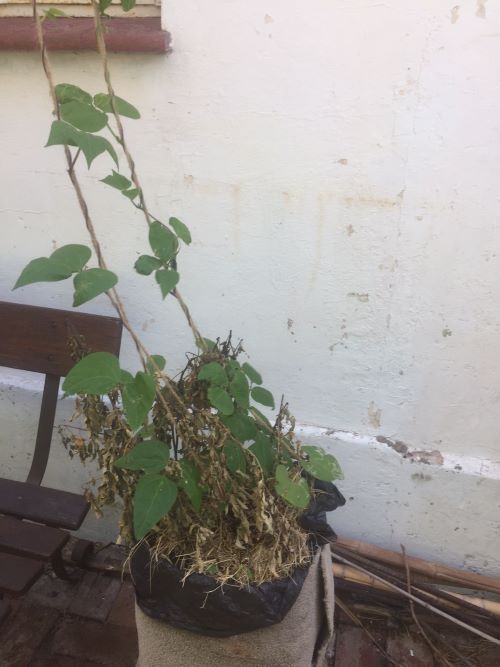 Beans emerging from their protective forest of leaves as protective leafy twigs dry out.
Beans emerging from their protective forest of leaves as protective leafy twigs dry out.If you know how to protect seedlings, you may avoid some of the pain that is part of the pleasure of gardening. I am never ever going to claim I'm a master, but I have learned a few tricks that may help a beginner or anyone struggling with the frustration of seedlings dying. Please share your tips below, in the comments form, if you wish to help !
It can be awful, especially when starting out. You spend all that money on seed and get nothing to show for it while people are posting giant cabbages on facebook. Let the green fingered people be smug. I struggle, and people respond to my cries for help with barely concealed smiles of condescension !!!
I hope I can help with the early steps of growing vegetables. Getting a huge harvest is something I am not close to mastering yet... I say yet in hope and indomitable stubbornness. There are many hurdles to be overcome.
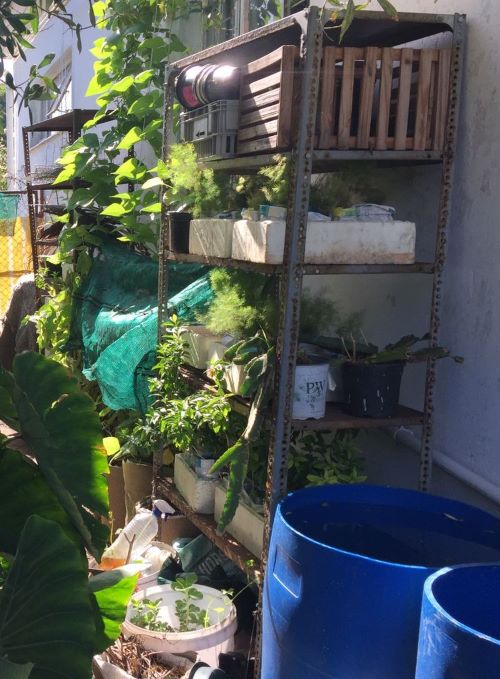 The seedling propagation area. Trays are placed on iron bars a meter off the ground between the two shelves. Covered with green shade net. The blue drums have a bubbler for dechlorintion and brews.
The seedling propagation area. Trays are placed on iron bars a meter off the ground between the two shelves. Covered with green shade net. The blue drums have a bubbler for dechlorintion and brews.GERMINATION
The first stage is germination.
TIMING
You need to sow in the right season. I find all of this really complex. To simplify I've divided the year into winter and summer vegetables... but there are still many outliers.
Do not believe the bloggers who say you can sow at any time. Seeds are intelligent and they love perfect timing. Plants need a certain number of days to harvest. Some seeds will give you more leeway. But if you are having no success with plant development it may just be timing.
One tip is to record the date of germination of anything you see self seeding in your garden. It may indicate the perfect time for sowing in your situation, climate and soil next year. And if you have icy winters, it may indicate the perfect timing for planting out in the open air.
Otherwise read read read and google of course, and ask around. The annual vegetable garden is a demanding master. Onions... oh onions... if you don't get the timing right you sit with them just vanishing before they are mature. You need onion types that are right for your day length too.
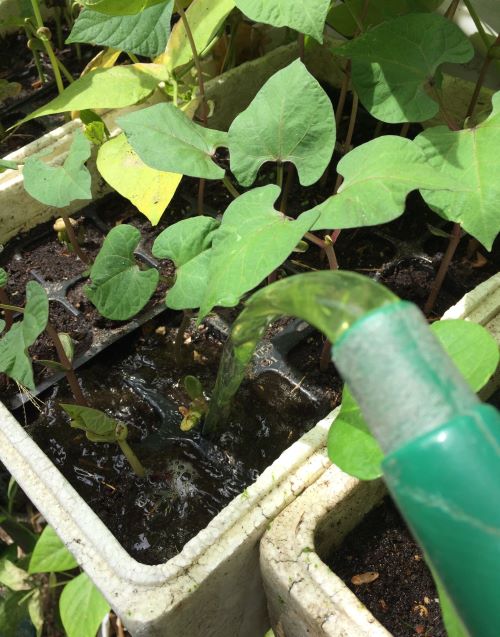 Water bean seed and seedlings daily and keep under shade net if you live in a hot dry climate. Elsewhere you will need to protect from cold and rain till summer comes.
Water bean seed and seedlings daily and keep under shade net if you live in a hot dry climate. Elsewhere you will need to protect from cold and rain till summer comes.WATER
l water my seedlings every day till they germinate. In our climate I also put them under shade net, close to the trays. Some people cover them with a board or something to keep in the mositure. I once forgot the beans for one day, early on, and fortunately they did come up. The shade net also protects the seedlings from our gale force winds coming in off the southern oceans after a hot day.
PROTECTION
Another function of the shade net is protection. For me its primarily from scratching birds who are after seed or a nice tasty sweet buds. Invasive Helix aspersa snails are also a big problem. My seed trays are hung on top of rebar or other iron bars lifted well off the ground. The bars get hot in the sun, and I've also heard snails don't like metal.
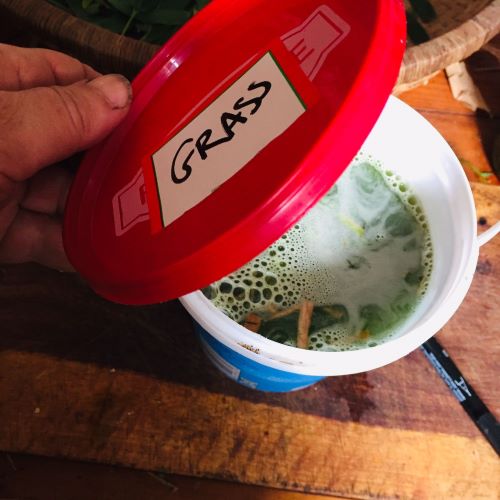 An experiment with plant juices. The reasoning more fully described in my newsletter on 14th, so sign up to get more informtion on this technique.
An experiment with plant juices. The reasoning more fully described in my newsletter on 14th, so sign up to get more informtion on this technique.MICROBIOME
I always have about 30% vermicast in the seedling mix. Apparently it has a very diverse micro flora. We've found this protects against damping off, which has not been a problem for decades in our garden. I'm starting to inoculate my seeds and seedlings. When seed is dried it loses most of its microbiome. The plant really needs those microbes to function properly and develop root hairs, and transfer of the mother plant's microbiome via seed is the chief way the plant gets the right microbes. Some kind of artificial microbiome boosting is therefore needed for dried seeds. I inoculate with brewed vermicast, minerals and natural nitrogen, and special plant juices. To find out more, sign up for my newsletter below.
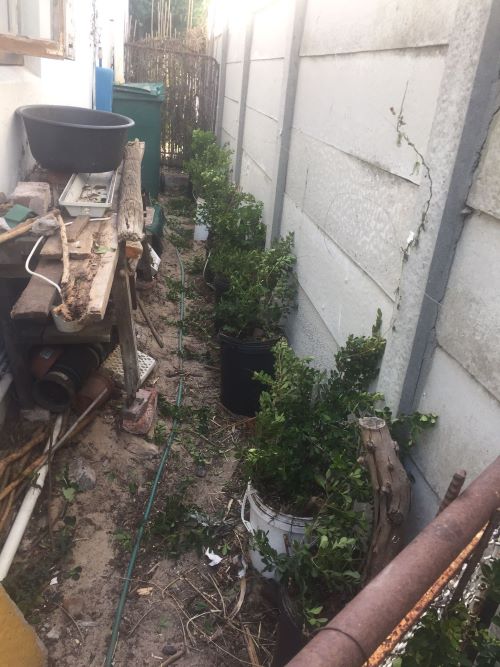 Alley with ten pots of bean seedlings hidden under protective leafy twigs. I used Searsia this time. You can tell I'm desparate for space to grow more beans.
Alley with ten pots of bean seedlings hidden under protective leafy twigs. I used Searsia this time. You can tell I'm desparate for space to grow more beans.PLANTING OUT AND TRANSPLANT SHOCK
Most gardeners probably hate transplant shock. This is why I've tried growing in toilet rolls, paper pots and plastic tubes. All of them were a fail for various reasons, mainly that I'm too busy and the pots have rotted by the time I get to transplant, and everything falls out.. back to square one and ROOT shock.
I've started prepping my transplants for a couple of days with a weak (you may try 1 teaspoon to a gallon or weaker) sugar solution. I happened to have some waste from our beehive and I have been brewing it up for a long time. You know the dirty stuff, dead bees, comb fragments etc. I put about 2 liters in a 500 liter drum with a bubbler. The point is to produce strong roots, and it seems to work, so that the plants pop out of the container in one piece even before the four leaf stage. The brew also contains a kelp, a very little ash, urine, bonemeal and fermented weeds.
Then I place the seed tray close to where the plants will be planted out in a few days to wean them off nursery conditions and harden them off.
When I plant them out I'm very gentle and water the trays and the soil they are going into thoroughly.
Last but not least, and this I learned from a master vegetable gardener in Cape Town with a fearsome reputation. I cut some leafy twigs and branches and poke them into the earth around the planted seedlings. As the twigs wither and the leaves drop, the plants are exposed to more sun, wind, or whatever the environment hostile to tender plants offers. Its even better if these twigs are from aromatic plants to repell insects and snails from the tender sweet young shoots.
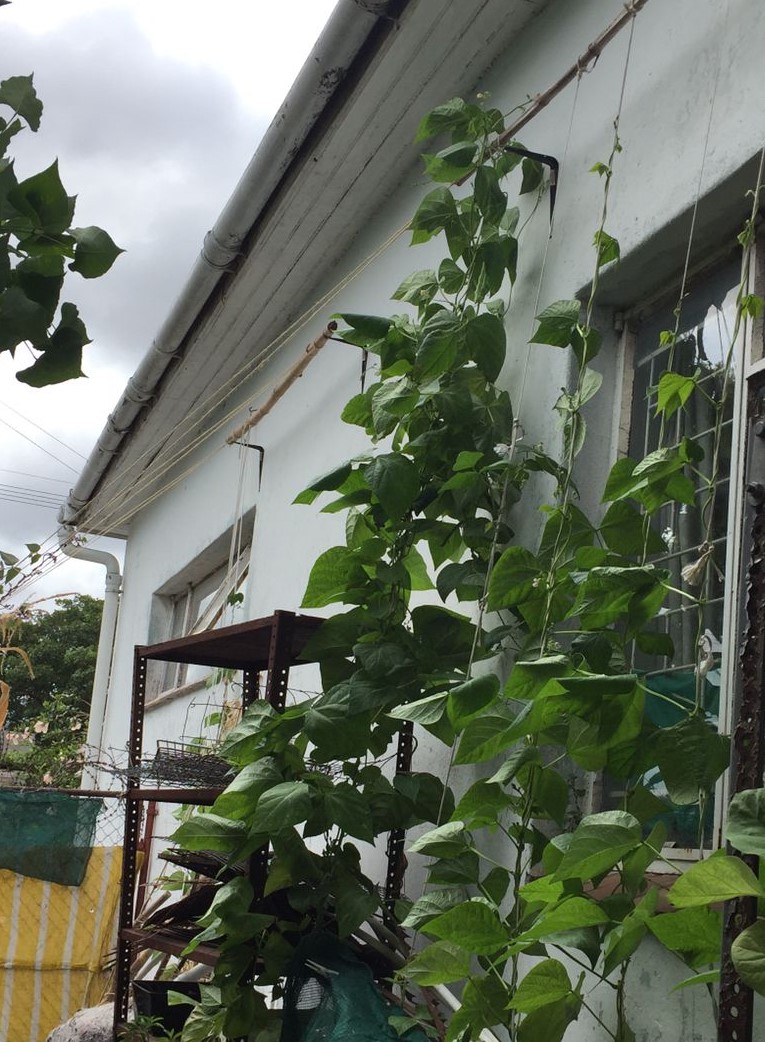 lusher than ever bean growth the second year in the same bags.
lusher than ever bean growth the second year in the same bags.PRODUCING PRODUCE
This last definitely has me stymied. My plants grow well but only produce the occasional handful of fruit. Green leafy vegetables I have in abundance, but anything with lots of carbohydrates like beans, onions, beets and even cabbages have outwitted me.
But the greatest limitation beyond my own ignorance, is space.
Being in the burbs, we've a lot of wall space, and I'm trying to use it to the maximum, even the ugly back alleys which end up storing lumber and other stuff. I've attached tiny hooks to the concrete wall. They just popped off when the wind blue, till I glued them on with epoxy steel glue. I am hoping that surrounding the house with green bean tunnels in the heat of our summer will make temperatures more bearable.
End of season update: I planted about 100 bean plants this year and had a weekly harvest of a handfull of beans for several months. I'm extremely happy with Blue Peter, it goes on late into winter. Rattlesnake beans were also reasonable, but the green beans with red seeds, whose name I've lost, were disappointing due to a limited season.
 A bean trellis of thin wire and lightweight string is held in place by these tiny self gluing hooks. They don't hold on the concrete till I used epoxy.
A bean trellis of thin wire and lightweight string is held in place by these tiny self gluing hooks. They don't hold on the concrete till I used epoxy.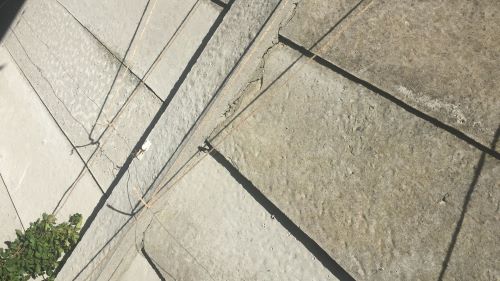 a bean trellis of thin wire and string
a bean trellis of thin wire and stringI find I can never have enough beans, and I save seed, and it costs me hours of work. I'm aiming for a base stock of 300 bean seeds going into every season. I mentioned this to a friend who lives near me in the same climate and soil, and he laughed and said it was excessive, and his vines produce lots of fruit. I gritted my teeth and smiled sweetly. Asked admiringly how he did it.. at which he mumbled and looked away and would not share his genius.
I hope by paying more attention to timing and fertilization, and building microbe rich soil to get there one day. I've also found that in my small suburban garden NOT doing crop rotation has an advantage. The second year has produced monster vegetables as all the right microbes are probably still in the soil. Perhaps later disease becomes a problem, but I'll cross that bridge when I get to it.
Restore Nature Newsletter
I've been writing for four years now and I would love to hear from you
Please let me know if you have any questions, comments or stories to share on gardening, permaculture, regenerative agriculture, food forests, natural gardening, do nothing gardening, observations about pests and diseases, foraging, dealing with and using weeds constructively, composting and going offgrid.
Garden for Life regenerative and biodiversity gardening blog
SEARCH
Order the Kindle E-book for the SPECIAL PRICE of only
Prices valid till 30.09.2023
Recent Articles
-
garden for life is a blog about saving the earth one garden at a time
Apr 18, 25 01:18 PM
The garden for life blog has short articles on gardening for biodiversity with native plants and regenerating soil for climate amelioration and nutritious food -
Cape Flats Sand Fynbos, Cape Town's most endangered native vegetation!
Apr 18, 25 10:36 AM
Cape Flats Sand Fynbos, a vegetation type found in the super diverse Cape Fynbos region is threatened by Cape Town's urban development and invasive alien plants -
Geography Research Task
Jan 31, 25 11:37 PM
To whom it may concern My name is Tanyaradzwa Madziwa and I am a matric student at Springfield Convent School. As part of our geography syllabus for this
"How to start a profitable worm business on a shoestring budget
Order a printed copy from "Amazon" at the SPECIAL PRICE of only
or a digital version from the "Kindle" store at the SPECIAL PRICE of only
Prices valid till 30.09.2023







